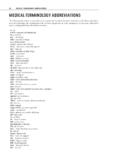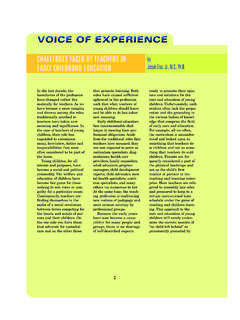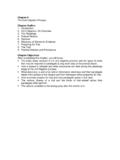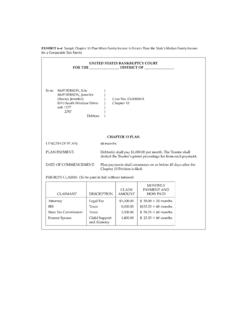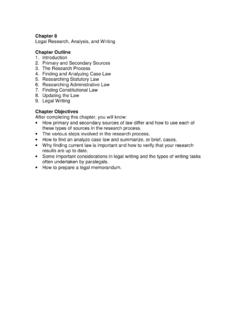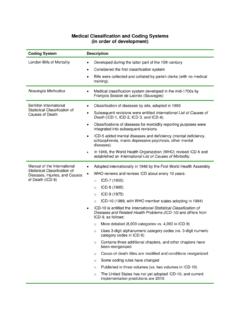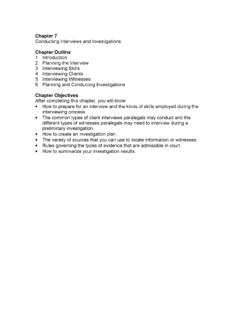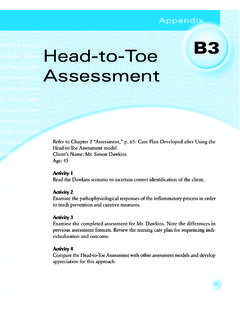Transcription of Infant and Toddler Activities - Cengage Learning
1 R-97 Because infants change and grow so quickly curriculum must adjust to their new developmental level. For this reason, activi-ties are designed as prototypes for young infants, birth to 9 months, mobile infants, 8 to 18 months, and toddlers, 16 to 36 months. If infants or toddlers are in the younger range or their disability affects this particular area, use Activities from a lower age range. If they are in the older range or Activities seem too easy, move into the Activities for older children, in resource Chapters 1 through GoalsThe Activities for infants and toddlers are divided into five broad areas: social awareness, language and com-munication skills, cognitive development, sensory motor skills, and creative development. Activities are organized by the goals they support.
2 The targeted age group for each activity is designated: young infants (birth to 9), mobile infants (8 to 18), and toddlers (16 to 36). If it is appropri-ate for a broader age range, the designation includes that information. A birth to 18 designation would include children from birth to 18 months. All activity areas begin with Activities for young infants, then Activities for mobile infants, and finally, Activities for toddlers. The Activities that are in the book have their number identified; those that are in the book companion website are followed by a w (refer to Tables R6 1 and R6 2). Infant and Toddler GuidelinesBecause infants and toddlers have a small repertoire the accommodations needed can be applied in general to all the listed Activities . The following list highlights accommodations.
3 They are more functional than accom-modations for older children. The accommodations for regulatory problems relate to children who may later be identified with specific Learning disabilities, attention-deficit/hyperactivity disorder, and social, emotional, and behavioral disorders as well as some children on the autism Activities for infants and toddlers with:Regulatory problems: DetachedFocus on one behavior at a time. Teach body awareness, especially problems: UnderreactiveUse massage. Direct and redirect children. Actively teach items you might assume others would learn. Use brief, focused lessons. Engage children; model and reinforce appropriate eye contact, facial expressions, and gestures. Model interactions. Use multimodal and Toddler Activities :Young Infants, Mobile Infants, and ToddlersResource Chapter R-9712/10/08 11:07:23 PM12/10/08 11:07:23 PMR-98 resource CHAPTER 6 Regulatory problems: HypersensitiveReduce excess stimuli (light, noise, activity).
4 Be consistent. Teach adaptive problems: Motorically disorganized/impulsive skillsDo a functional behavior assessment if undesirable behaviors continue and do not respond to traditional guidance. Try reinforcing quiet behavior with a special audiotape (turn off the tape if the child cries and so on). Redirect behavior. Give intermittent reinforcement. Work on self-control and problems: DysregulatedIgnore inappropriate crying. Reinforce appropriate responses to situations. Be available. Develop a predictable schedule, especially as it relates to sleeping and eating. Teach infants and toddlers to self-comfort. Use music to set a mood. Gradually increase environmental disordersTalk to infants and toddlers. Support all communication. Build language and vocabulary. Help children respond to people and environmental stimuli.
5 Look at communication as social language learnersSupport children in developing vocabulary and language in their home language and English. Provide context for language Learning . If helpful, use a simple picture communication system for toddlers to show how they are feeling or what they disabilitiesUse toys that respond (shake rattle, it makes noise). Use verbal and physical prompts. Support and enhance a child s capabilities. Model desired behavior. Work toward independence in eating, dressing, and grooming. Use a picture-task and talentedProvide Activities with cause-effect relationships. Increase complexity while keeping Activities at a developmentally appropriate level (read books with more details). Encourage and support motor skills. Be health care needsNormalize the educational setting within the medical aspects of health.
6 Adapt to physical limitation, stamina, and endurance levels by flexible schedules. Learn danger signs and side effects of treatments (appetite loss, mood swings, hair loss, and so on) and develop a plan to deal with these. Have an emergency care and neurologicHelp children move as normally as possible. Work toward symmetry (using both sides of the body equally). Check with a physical or occupational therapist for the best way to position children. Actively promote peer impairmentsUse visual and tactile stimulation. Promote the use of auditory aids. Talk to children and use the communication system the family has chosen. Supplement this with pictures and photographs for choices and to support Learning impairmentsUse auditory and tactile stimulation. Promote the use of visual aids. Help children develop appropriate responses to auditory stimulation (look at speaker).
7 Promote social interaction and R6 1: Activity goals and activity numbers in text and onlineGoalsActivity NumbersTo increase social awareness 6 1, 6 2, 6 3, 6 4, 6 5, 6 6, 6 15, 6 25, 6 306 31w, 6 32w, 6 33w, 6 34w, 6 36w, 6 42w, 6 43w, 6 52w, 6 54w, 6 63wTo increase language and communication skills 6 3, 6 5, 6 7, 6 8, 6 9, 6 10, 6 11, 6 12, 6 16, 6 18, 6 23, 6 286 32w, 6 34w, 6 35w, 6 36w, 6 37w, 6 38w, 6 39w, 6 40w, 6 41w, 6 42w, 6 52w, 5 53w, 6 R-9812/10/08 11:07:26 PM12/10/08 11:07:26 PM Infant and Toddler Activities : Young Infants, Mobile Infants, and Toddlers R-99To increase cognitive development 6 1, 6 7, 6 8, 6 13, 6 14, 6 15, 6 16, 6 17, 6 18, 6 19, 6 20, 6 21, 6 22, 6 246 35w, 6 38w, 6 43w, 6 44w, 6 45w, 6 46w, 6 47w, 6 48w, 6 49w, 6 50w, 6 51w, 6 55w, 6 56w, 6 57wTo increase sensory motor skills 6 2, 6 4, 6 5, 6 6, 6 9, 6 10, 6 12, 6 13, 6 14, 6 17, 6 18, 6 19, 6 20, 6 21, 6 22, 6 23, 6 24, 6 25, 6 26, 6 27, 6 296 31w, 6 32w, 6 33w, 6 34w, 6 35w, 6 36w, 6 39w, 6 40w, 6 41w, 6 44w, 6 45w, 6 46w, 6 47w, 6 48w, 6 49w, 6 50w, 6 51w, 6 52w, 6 53w, 6 54w, 6 55w, 6 56w, 6 57w, 6 58w, 6 59w, 6 60w, 6 61w, 6 62wTo increase creative development 6 10, 6 11, 6 25, 6 26, 6 27, 6 28, 6 29, 6 306 58w, 6 59w, 6 60w, 6 61w, 6 62w, 6 63wTable R6 2.
8 Age and reference numbersAgeActivity NumbersYoung infants (B to 9 months) 6 1, 6 2, 6 7, 6 8, 6 13, 6 14, 6 18, 6 20, 6 25, 6 266 31w, 6 32w, 6 35w, 6 43w, 6 44w, 6 49w, 6 50wMobile infants (8 to 18 months) 6 3, 6 4, 6 9, 6 10, 6 15, 6 16, 6 21, 6 22, 6 27, 6 286 33w, 6 45w, 6 46w, 6 51wMobile infants and toddlers (8 to 36 months) 6 52w, 6 53w, 6 54w, 6 58w, 6 59wToddlers (16 to 36 months) 6 5, 6 6, 6 11, 6 12, 6 17, 6 18, 6 23, 6 24, 6 29, 6 306 33w, 6 36w, 6 37w, 6 38w, 6 39w, 6 40w, 6 41w, 6 42w, 6 47w, 6 48w, 6 55w, 6 56w, 6 57w, 6 60w, 6 61w, 6 62w, 6 63wInfant and Toddler ActivitiesSocial Awareness: Individual, birth to 9 months6-1 AnticipationGoals: To increase social awareness; to increase cognitive developmentMaterials: NoneProcedure: Before beginning an event such as giving an Infant a bottle, picking him up, or changing him, tell the Infant what is going to happen.
9 Show the Infant the bottle and say, Are you hungry? I have your bottle ready. Do you want it? Then pause to give the Infant time to respond. (Don t expect him to say yes, you are giving him the time and respect to process information rather than just putting the bottle in his mouth.) Before picking up an Infant hold out your arms and say, I m going to pick you up. Then pause so the Infant can anticipate what will happen. Keep the gestures and words you use consistent so the Infant knows what to expect. Follow through with the action quickly; if you show him the bottle and he responds, then feed him right away; do not wait several minutes. Respond to the Infant s cues. If he quiets when approaching him say, You know I m going to pick you up. Then do : The Infant increases the amount of time he can wait for an anticipated activity without : As infants learn that their world is predictable they are willing to wait longer for events to happen because they are developing R-9912/10/08 11:07:26 PM12/10/08 11:07:26 PMR-100 resource CHAPTER 6 Social Awareness: Individual, B to 9 months6-2 Tummy TimeGoal To increase social awareness, to increase sensory motor skillsMaterials: NoneProcedure: Tummy time is whenever infants are not on their backs or sitting in seats or other containers.
10 Carrying infants in different ways changes their view of the world and also helps them strengthen needed muscles. As you carry young infants point out items they can see, talk, or sing to them. Stomach down: To carry an Infant stomach down place one arm underneath his chest with the hand supporting his chin and neck. The other arm goes around his entire body. Back to front vertical: Pick up the Infant so his back is toward your front. Carry him in a vertical position so his head is up and he is looking out. For young babies keep their head centered as you hold them. As infants get older have them put their arms out and pretend to fly. As a variation put one arm under the Infant to make a seat and the other arm around his middle for support. Back to front horizontal: Pick up the Infant so his back is toward your front.

